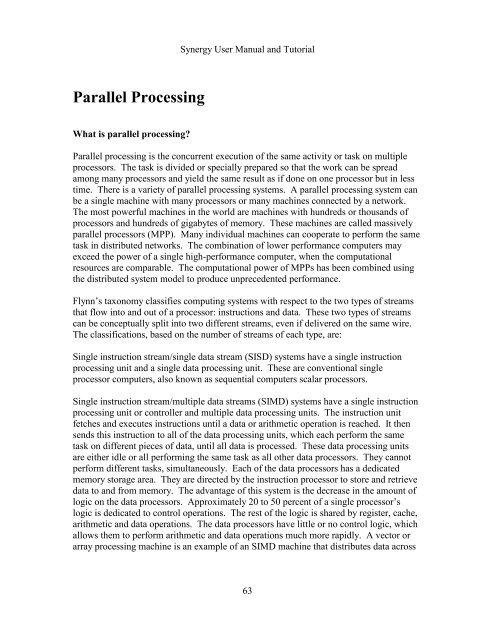Synergy User Manual and Tutorial. - THE CORE MEMORY
Synergy User Manual and Tutorial. - THE CORE MEMORY
Synergy User Manual and Tutorial. - THE CORE MEMORY
You also want an ePaper? Increase the reach of your titles
YUMPU automatically turns print PDFs into web optimized ePapers that Google loves.
<strong>Synergy</strong> <strong>User</strong> <strong>Manual</strong> <strong>and</strong> <strong>Tutorial</strong><br />
Parallel Processing<br />
What is parallel processing?<br />
Parallel processing is the concurrent execution of the same activity or task on multiple<br />
processors. The task is divided or specially prepared so that the work can be spread<br />
among many processors <strong>and</strong> yield the same result as if done on one processor but in less<br />
time. There is a variety of parallel processing systems. A parallel processing system can<br />
be a single machine with many processors or many machines connected by a network.<br />
The most powerful machines in the world are machines with hundreds or thous<strong>and</strong>s of<br />
processors <strong>and</strong> hundreds of gigabytes of memory. These machines are called massively<br />
parallel processors (MPP). Many individual machines can cooperate to perform the same<br />
task in distributed networks. The combination of lower performance computers may<br />
exceed the power of a single high-performance computer, when the computational<br />
resources are comparable. The computational power of MPPs has been combined using<br />
the distributed system model to produce unprecedented performance.<br />
Flynn’s taxonomy classifies computing systems with respect to the two types of streams<br />
that flow into <strong>and</strong> out of a processor: instructions <strong>and</strong> data. These two types of streams<br />
can be conceptually split into two different streams, even if delivered on the same wire.<br />
The classifications, based on the number of streams of each type, are:<br />
Single instruction stream/single data stream (SISD) systems have a single instruction<br />
processing unit <strong>and</strong> a single data processing unit. These are conventional single<br />
processor computers, also known as sequential computers scalar processors.<br />
Single instruction stream/multiple data streams (SIMD) systems have a single instruction<br />
processing unit or controller <strong>and</strong> multiple data processing units. The instruction unit<br />
fetches <strong>and</strong> executes instructions until a data or arithmetic operation is reached. It then<br />
sends this instruction to all of the data processing units, which each perform the same<br />
task on different pieces of data, until all data is processed. These data processing units<br />
are either idle or all performing the same task as all other data processors. They cannot<br />
perform different tasks, simultaneously. Each of the data processors has a dedicated<br />
memory storage area. They are directed by the instruction processor to store <strong>and</strong> retrieve<br />
data to <strong>and</strong> from memory. The advantage of this system is the decrease in the amount of<br />
logic on the data processors. Approximately 20 to 50 percent of a single processor’s<br />
logic is dedicated to control operations. The rest of the logic is shared by register, cache,<br />
arithmetic <strong>and</strong> data operations. The data processors have little or no control logic, which<br />
allows them to perform arithmetic <strong>and</strong> data operations much more rapidly. A vector or<br />
array processing machine is an example of an SIMD machine that distributes data across<br />
63

















